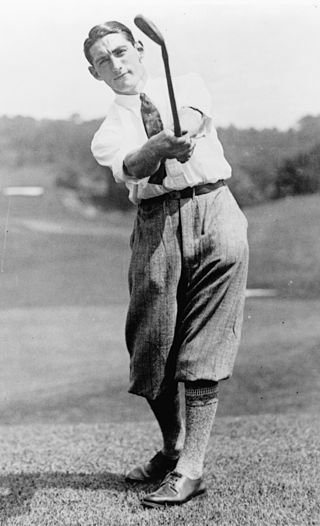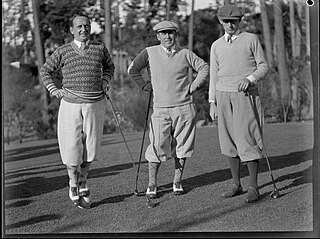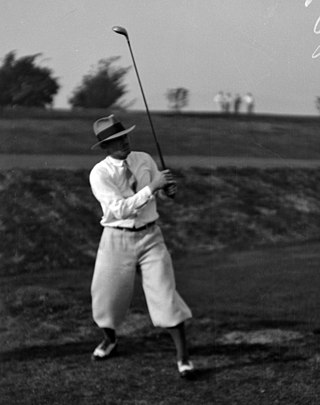
Thomas Dickson Armour was a Scottish-born golfer who played primarily in the United States. He was nicknamed The Silver Scot. He was the winner of three of golf's major championships: 1927 U.S. Open, 1930 PGA, and 1931 Open Championship. Armour popularized the term yips, the colloquial term for a sudden and unexplained loss of skills in experienced athletes.

Robert Allan Cruickshank was a Scottish-born golfer who played primarily in the United States. He competed in the PGA of America circuit in the 1920s and 1930s, the forerunner of the PGA Tour. He was twice runner-up at the U.S Open.

John Joseph Farrell was an American professional golfer, best known for winning the U.S. Open in 1928. Over the course of his career, he won 22 PGA Tour events.

Walter Charles Hagen was an American professional golfer and a major figure in golf in the first half of the 20th century. His tally of 11 professional majors is third behind Jack Nicklaus (18) and Tiger Woods (15). Known as the "father of professional golf," he brought publicity, prestige, big prize money, and lucrative endorsements to the sport. Hagen is rated one of the greatest golfers ever.

William Earl Mehlhorn was an American professional golfer who played on the PGA Tour in its early days, and was at his best in the 1920s.

Johnny Golden was an American professional golfer.
James R. Turnesa was an American professional golfer and winner of the 1952 PGA Championship, beating Chick Harbert 1-up in the match-play final. He was one of seven famous golfing brothers; Phil (1896–1987), Frank (1898–1949), Joe (1901–1991), Mike (1907–2000), Doug (1909–1972), Jim (1912–1971), and Willie (1914–2001). The family was referred to as a "golf dynasty" in a 2000 New York Times article.
The North and South Open was one of the most prestigious professional golf tournaments in the United States in the first half of the twentieth century. It was played at Pinehurst Resort in North Carolina, long the largest golf resort in the world, which also staged a series of other tournaments with the "North and South" name, some of which continue to this day.

Albert Andrew Watrous was an American professional golfer who played on the PGA Tour in the 1920s and 1930s.

Samuel Dewey Byrd was an American professional baseball outfielder and professional golfer. He played in Major League Baseball (MLB) and on the PGA Tour. Byrd is the only person to play in both the World Series and the Masters Tournament.

Michael C. Turnesa was an American professional golfer.
The Massachusetts Open is the Massachusetts state open golf tournament. The brothers Donald Ross and Alex Ross had much success early in the tournament's history, winning the first eight events between them. In the mid-1910s, the Massachusetts Golf Association opened the event to golfers outside the state. The tournament evolved into an event of national significance as legendary golfers like Walter Hagen, Gene Sarazen, and Byron Nelson won during the era. In the 1940s, the event evolved into more of a local affair though many of the top pros from Massachusetts played. In the late 20th and early 21st century, PGA Tour pros from the state like Paul Harney, Dana Quigley, and Geoffrey Sisk won the event several times each.
William P. Turnesa was an American amateur golfer, best known for winning two U.S. Amateur titles and the British Amateur.
The 1926 U.S. Open was the 30th U.S. Open, held July 8–10 at Scioto Country Club in Columbus, Ohio. Noted amateur Bobby Jones, winner of the British Open two weeks earlier, won the second of his four U.S. Opens, one stroke ahead of runner-up Joe Turnesa.
The 1927 PGA Championship was the 10th PGA Championship, held from October 31 to November 5 in Texas at Cedar Crest Country Club in Dallas. Then a match play championship, Walter Hagen defeated Joe Turnesa 1 up in the finals to win his fourth consecutive PGA Championship, his fifth and final overall, and the ninth of his eleven major titles.
Wilfred Hiram "Wiffy" Cox was an American professional golfer who played on the PGA Tour in the 1930s.
The Sacramento Open was a golf tournament on the PGA Tour from 1926 to 1938. It was held in Sacramento, California at two different courses. In the 1920s, it was played at the Del Paso Country Club. In the 1930s, it was played at a municipal course that is now part of the Haggin Oaks Golf Complex.
The Long Island Open is a professional golf tournament played on Long Island, New York. It is sponsored by the Long Island Golf Association and was first held in 1922 at the Cherry Valley Club in Garden City, New York.
The Connecticut PGA Championship is a golf tournament that is a championship of the Connecticut section of the PGA of America. The early years of the tournament were dominated by Gene Kunes and Joe Turnesa who won twice apiece. In the mid-1930s, a number of significant changes were made, including adding two rounds to the tournament and then changing the format to match play. In the mid-20th century the tournament was dominated by Eddie Burke and Bob Kay. During this era, both won the tournament five times each though Kay defeated Burke in both of their finals matches. In modern times, the tournament is best known for the 2002 victory of Suzy Whaley, the only female to win the event.
The New York State Open was the state open golf tournament of the state of New York from 1928 to 1930. In early 1928, the New York State Golf Association announced that they had the financial support from Onondaga Country Club in Syracuse to host their first state open. The first event was supposed to be limited to New York state residents but when golfers from other parts of the country arrived in Syracuse tournament officials let them in. The following year, officials formally allowed golfers from other states to participate. Billy Burke won the event over a number of "star" golfers. The following year's event was a three-horse battle between Burke, Wiffy Cox, and recent U.S. Open champion Johnny Farrell with Farrell coming out on top. Later in 1930, the state's golf association announced that the event would be "dropped" due to financial concerns.








